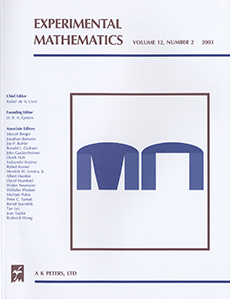Abstract
Let D be a positive integer such that D and $D{-}1$ are not perfect squares; denote by $X_0$, $Y_0$, $X_1$, $Y_1$ the least positive integers such that $X_0^2 - (D{-}1) Y_0^2 = 1$ and $X_1^2 - D Y_1^2 = 1$; and put $\rho(D) = \log X_1 / \log X_0$. We prove here that $\rho(D)$ can be arbitrarily large. Indeed, we exhibit an infinite family of values of D for which $\rho(D) \gg D^{1/6}/ \log D$. We also provide some heuristic reasoning which suggests that there exists an infinitude of values of D for which $\rho(D) \gg \sqrt{D} \log \log D / \log D$, and that this is the best possible result under the Extended Riemann Hypothesis. Finally, we present some numerical evidence in support of this heuristic.
Citation
Michael J. Jacobson Jr.. Hugh C. Williams. "The size of the fundamental solutions of consecutive Pell equations." Experiment. Math. 9 (4) 631 - 640, October 2000.
Information




